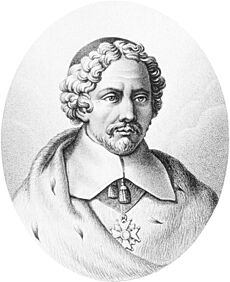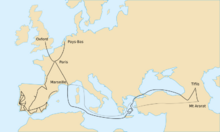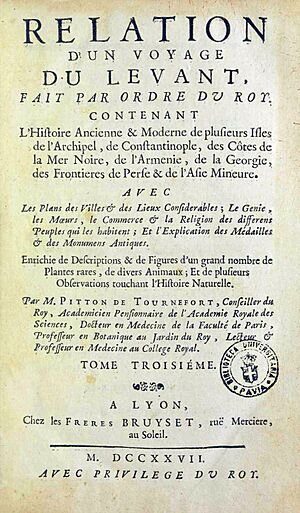Joseph Pitton de Tournefort facts for kids
Quick facts for kids
Joseph Pitton de Tournefort
|
|
|---|---|
 |
|
| Born | 5 June 1656 |
| Died | 28 December 1708 (aged 52) |
| Nationality | French |
| Alma mater | University of Paris |
| Known for | genus |
| Scientific career | |
| Fields | botany |
Joseph Pitton de Tournefort (born June 5, 1656 – died December 28, 1708) was a French botanist. He is famous for being the first person to clearly define the idea of a genus for plants. Think of a genus as a group of very similar plants. For example, all different kinds of roses belong to the same genus.
A botanist named Charles Plumier was his student. He even traveled with Tournefort on some of his exciting journeys.
Life and Journeys
Joseph Pitton de Tournefort was born in a town called Aix-en-Provence in France. He first studied at a Jesuit school there. His family wanted him to become a priest. However, after his father passed away, he was able to follow his real passion: studying plants!
He spent two years collecting plants. Then, he studied medicine at Montpellier. In 1683, he became a professor of botany at the Jardin des Plantes in Paris. This is a famous botanical garden. During this time, he traveled all over Western Europe. He especially explored the Pyrenees mountains, where he gathered many plant samples.
Between 1700 and 1702, Tournefort went on an amazing journey. He traveled through the islands of Greece and visited Constantinople (now Istanbul). He also explored areas near the Black Sea, Armenia, and Georgia. On these trips, he collected many plants and made other important observations.
He was joined by a German botanist named Andreas von Gundelsheimer and an artist named Claude Aubriet. Sadly, Tournefort died in Paris after being hit by a carriage. The street where he died is now named after him (Rue de Tournefort). His detailed descriptions of his travels were published after his death.
His Important Work
Tournefort's most important book was published in 1694. It was called Eléments de botanique, ou Méthode pour reconnaître les Plantes. This means "Elements of Botany, or Method for Recognizing Plants." The main artist for this book was Claude Aubriet, who later became the chief artist at the Jardin des Plantes.
In this book, Tournefort grouped about 7,000 different plant species into around 700 genera. He made it much easier for scientists to identify and organize plants. His book was written very clearly and was well-organized. It contained a lot of useful information about individual plant species. Because of this, it became very popular among botanists. Many plant classifications for the next 50 years were based on his work.
Tournefort is often given credit for being the first to clearly separate the ideas of a genus and a species. While others before him had similar ideas, his work made it very clear and popular.
He also seems to have invented the word "herbarium". A herbarium is a collection of dried plants that are pressed and kept for scientific study. Before Tournefort, these collections had many different names.
His own collection of nearly 7,000 plant specimens was kept in Paris. Today, it is part of the Muséum national d'histoire naturelle, which is a national natural history museum.
In 1858, a plant genus from South America was named Pittoniotis in his honor. This shows how important his work was to the world of botany.
Selected Publications
- Histoire des plantes qui naissent aux environs de Paris (History of Plants Growing Around Paris), 1698
- Relation d'un voyage du Levant (Account of a Journey to the Levant), 1717
- Traité de la matière médicale (Treatise on Medical Matter), 1717
See also
 In Spanish: Joseph Pitton de Tournefort para niños
In Spanish: Joseph Pitton de Tournefort para niños



